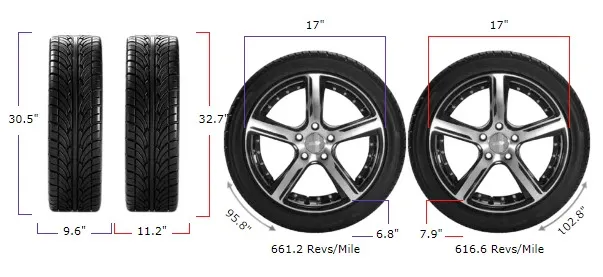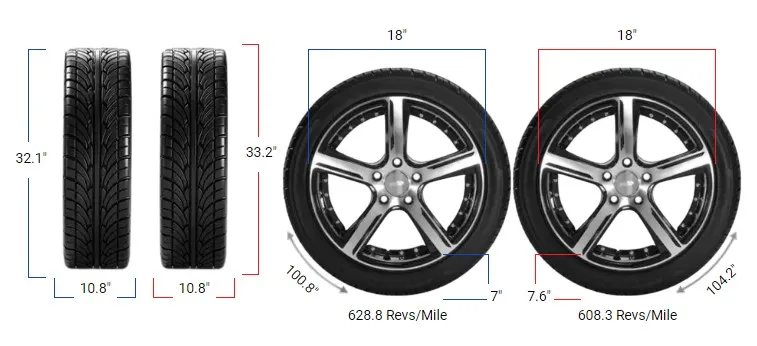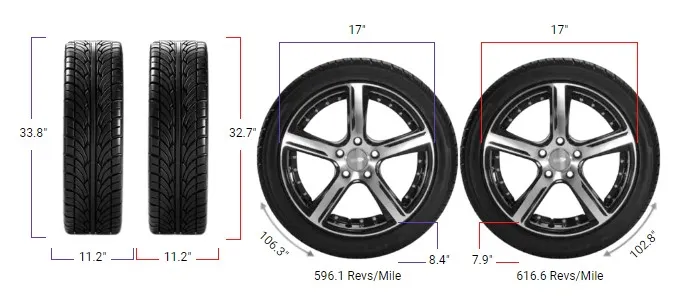Tire Size 245/70r17 vs 285/70r17
 Considering a tire upgrade? Switching from 245/70r17 to 285/70r17 can significantly change your vehicle’s performance. Let’s break down what this means for your driving experience.
Considering a tire upgrade? Switching from 245/70r17 to 285/70r17 can significantly change your vehicle’s performance. Let’s break down what this means for your driving experience.
- The 285/70R17 offers a larger diameter for enhanced ground clearance.
- A wider tire improves traction and stability on various surfaces.
- The increased sidewall height provides better cushioning on rough roads.
- Fuel efficiency may decrease due to the increased tire size and weight.
- The aggressive appearance of the wider tire can enhance the vehicle’s look.
- Fitting the larger tire may require modifications to the vehicle’s wheel wells.

Fitment Guide
According to the Fitment Guide, replacement tires should be within plus or minus 3% of the original diameter. The diameter difference here is 7.2%, which exceeds the acceptable range.
Therefore, switching to a 285/70r17 is not recommended without making necessary adaptations to prevent issues like rubbing or clearance problems.
On-Road Impact
Changing tire size can greatly influence how your vehicle behaves on regular roads. Here’s how moving to 285/70r17 tires affects on-road performance:

- Ground Clearance: The larger diameter increases ground clearance by about 1.1 inches (28 mm). This helps you drive over speed bumps and rough roads more easily, but it also raises your vehicle’s center of gravity, which can affect stability during sharp turns.
- Gas Mileage: Wider and taller tires are heavier, causing your engine to work harder. This can lead to a noticeable decrease in fuel efficiency, meaning you might visit the gas station more often.
- Aesthetic Look: The 285/70r17 tires give your vehicle a much more aggressive and rugged appearance. This bold look is appealing to many, but some might find the larger size makes the vehicle look bulky.
- Ride Comfort: The increased sidewall height (a 16.3% increase) provides more cushioning between the wheel and the road. This can result in a smoother ride over bumps and potholes, enhancing overall comfort.
- Speedometer Accuracy: With a larger circumference, your speedometer will read lower than your actual speed. For example, when your speedometer shows 20 mph, you’re actually traveling at 21.45 mph. This discrepancy can lead to unintentional speeding if you’re not careful.
- Handling: The wider tires can improve grip on dry roads, enhancing cornering ability. However, the increased size may also make steering feel heavier and less responsive, affecting overall handling.
- Durability & Wear: Larger tires can wear differently compared to smaller ones. The increased sidewall can flex more, potentially leading to faster wear if not properly maintained. Ensuring correct tire pressure and regular rotation is essential for longevity.
Off-Road Impact
If you enjoy off-roading, larger tires can offer both advantages and challenges. Here’s how the 285/70r17 tires affect off-road performance:

- Traction: The wider footprint improves grip on loose surfaces like mud and sand, enhancing your vehicle’s ability to navigate challenging terrains. This can make off-roading smoother and more controlled.
- Obstacle Navigation: The increased diameter helps your tires roll over obstacles like rocks and logs more easily, reducing the risk of getting stuck and improving your vehicle’s off-road capability.
- Clearance Issues: The significant size increase may cause the tires to rub against the wheel wells or suspension components, especially during extreme articulation. This can lead to damage over time and may require modifications such as installing a lift kit or adjusting suspension parts.
- Vehicle Stress: Bigger tires put additional strain on your vehicle’s drivetrain and brakes. This extra stress can lead to faster wear of these components, potentially necessitating upgrades to handle the increased load.
- Tire Pressure Adjustments: Off-roading often requires different tire pressure settings for optimal performance. The larger 285/70r17 tires may need specific pressure adjustments to perform effectively without risking damage.
245/70r17 vs 285/70r17
This table compares the key features of tire sizes 245/70R17 and 285/70R17.
| Feature | 245/70R17 | 285/70R17 | Difference |
|---|---|---|---|
| Diameter inches (mm) | 30.5 (774.8) | 32.71 (830.8) | 2.2 (56) 7.2% |
| Width inches (mm) | 9.65 (245) | 11.22 (285) | 1.57 (40) 16.3% |
| Circumference inches (mm) | 95.83 (2434.11) | 102.76 (2610.04) | 6.93 (175.93) 7.2% |
| Sidewall Height inches (mm) | 6.75 (171.5) | 7.85 (199.5) | 1.1 (28) 16.3% |
| Revolutions per mile (km) | 661.16 (410.83) | 616.6 (383.14) | -44.57 (-27.69) -6.7% |
| Speedo Reading | 20 mph (32.19 km/h) | 21.45 mph (34.51 km/h) | +1.45 mph |
Difference Between 245/70R17 and 285/70R17
The main difference is width; the 285/70R17 tire is 1.57 inches (40 mm) wider than the 245/70R17, a 16.3% increase, offering a broader footprint and enhanced traction.
Can I Use 285/70R17 Instead of 245/70R17?
It’s not recommended, as the 285/70R17 tire is 7.2% larger in diameter, exceeding the advised maximum difference of 3%. This may impact handling, braking, and speedometer accuracy.
How Much Taller Is a 285/70R17 Tire Than a 245/70R17?
The 285/70R17 tire is 2.2 inches (56 mm) taller than the 245/70R17, a 7.2% increase in overall diameter.
How Much Wider is a 285/70R17 Tire Than a 245/70R17?
The 285/70R17 tire is 1.57 inches (40 mm) wider than the 245/70R17, representing a 16.3% increase in width.
Our Observation
Switching from 245/70r17 to 285/70r17 offers both significant benefits and notable drawbacks. On-road, you’ll experience increased ground clearance and a more aggressive look, along with a smoother ride thanks to the taller sidewalls.
However, the 7.2% increase in diameter surpasses the recommended limit, leading to potential issues like inaccurate speedometer readings and heavier steering.
Fuel efficiency is likely to decrease due to the larger, heavier tires. Off-road, the benefits are more pronounced with better traction and enhanced ability to navigate obstacles.
Nevertheless, the substantial size increase can cause clearance problems and put extra stress on your vehicle’s drivetrain and brakes, requiring possible modifications.
While some changes, like improved ride comfort and traction, are beneficial, others, such as fuel consumption and handling differences, are significant and should be carefully considered.
Overall, the switch to 285/70r17 tires is a major change that can enhance both on-road and off-road performance but comes with challenges that may require additional adaptations to your vehicle.



